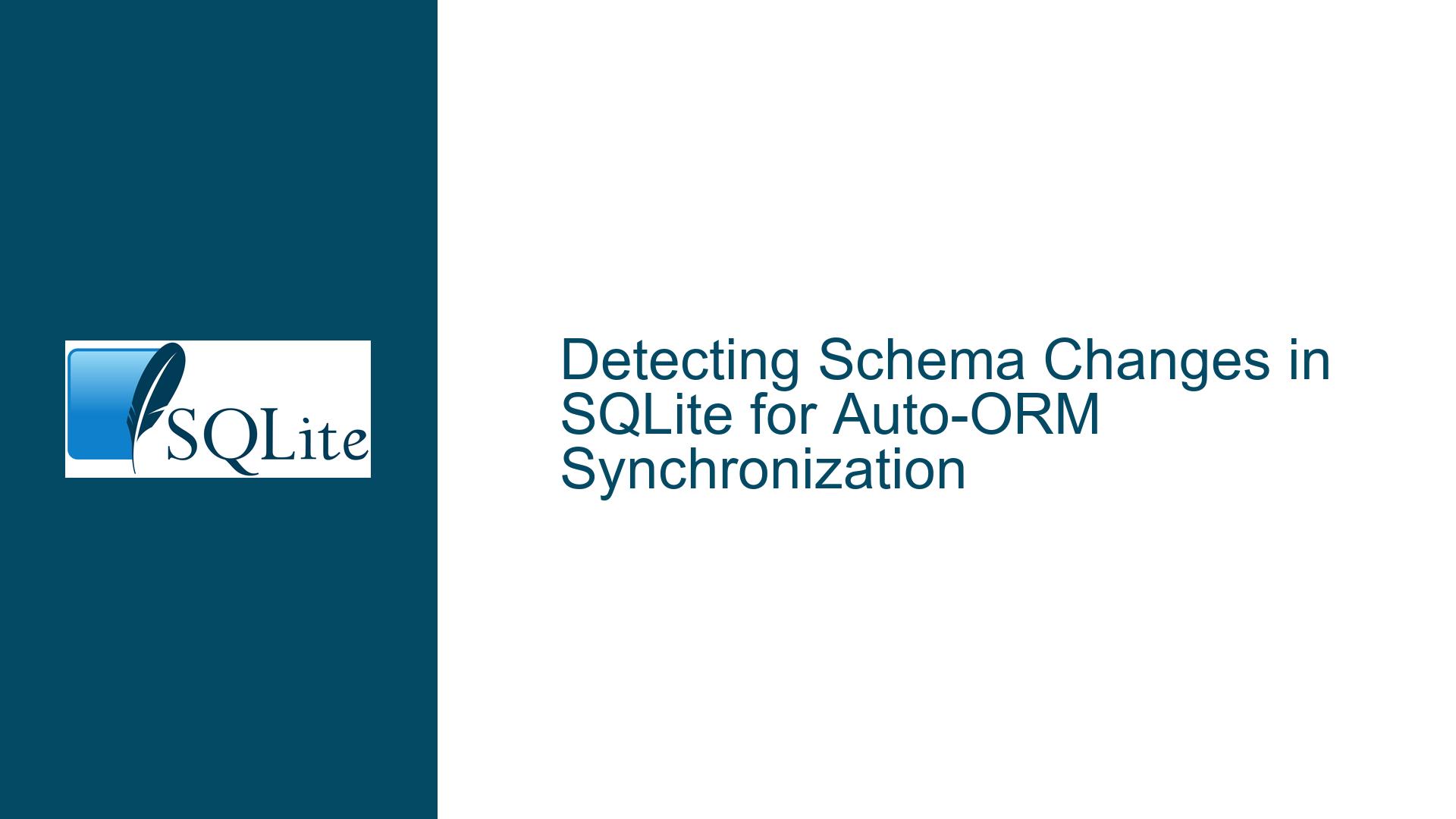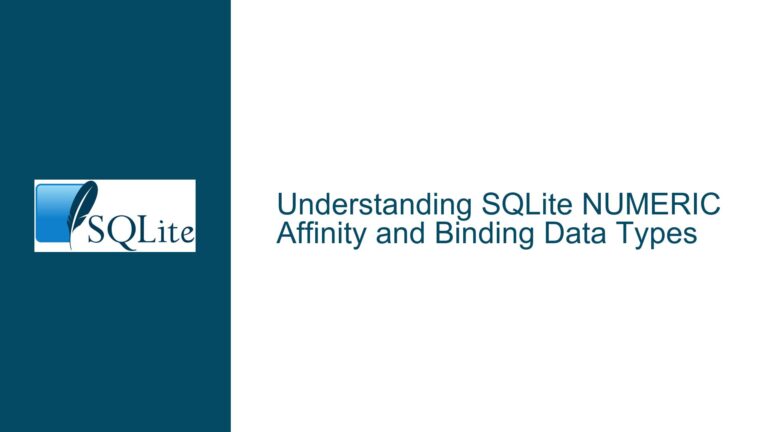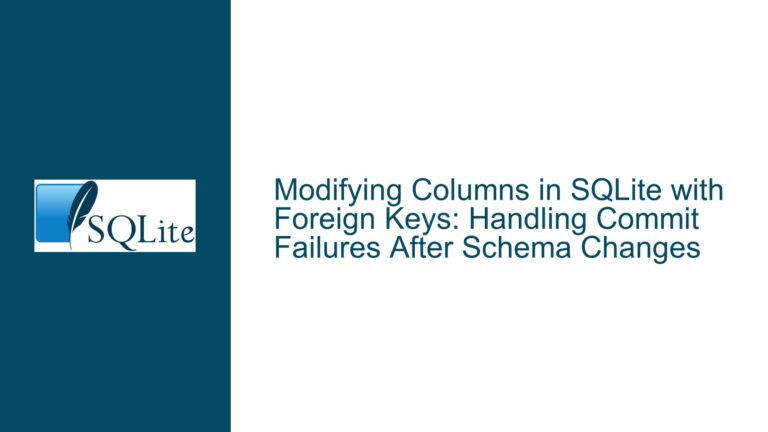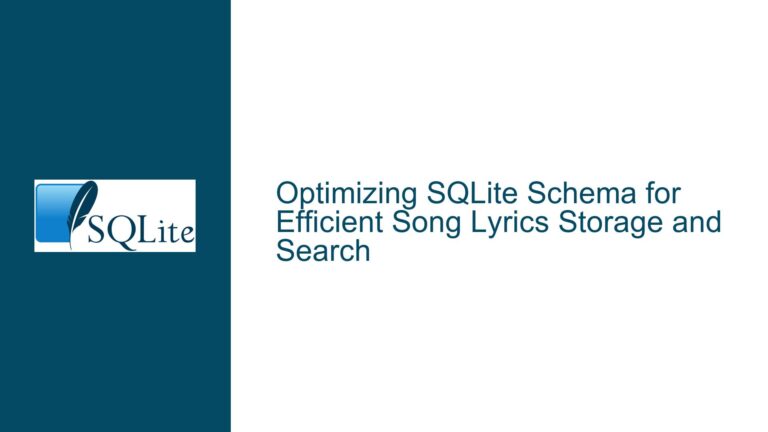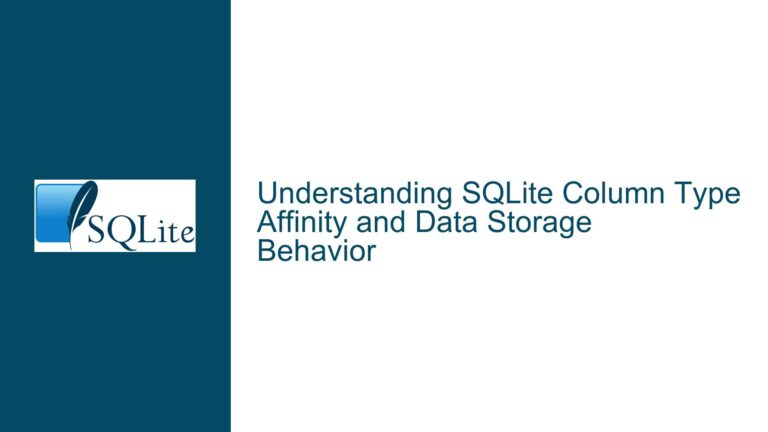Detecting Schema Changes in SQLite for Auto-ORM Synchronization
Understanding the Need for Schema Change Detection in SQLite-Based Applications
The challenge of detecting schema changes in SQLite databases arises when applications depend on up-to-date knowledge of table and view structures. This is particularly critical for auto-ORM (Object-Relational Mapping) systems, where internal mappings between application objects and database structures must stay synchronized with schema modifications. SQLite does not provide a direct event-driven mechanism (e.g., hooks or callbacks) for schema changes, forcing developers to devise alternative strategies. This guide explores the technical landscape of schema change detection, evaluates common pitfalls in existing approaches, and provides actionable solutions to ensure efficient synchronization.
Root Causes of Schema Change Detection Challenges in SQLite
1. Absence of Native Schema Change Hooks
SQLite’s architecture prioritizes simplicity and portability, which means it lacks built-in notifications or hooks for Data Definition Language (DDL) operations such as CREATE, ALTER, or DROP. Unlike client-server databases that may offer trigger-like mechanisms for metadata changes, SQLite requires external logic to detect schema modifications. This design choice reduces overhead but shifts the burden of tracking schema changes to developers.
2. Overhead of Frequent sqlite_master Scans
The sqlite_master system table contains metadata about database objects (tables, indexes, views, triggers). Scanning this table repeatedly to detect changes introduces performance penalties, especially in high-throughput applications. For auto-ORM systems, frequent scans can degrade response times and increase resource consumption, making lightweight alternatives desirable.
3. Limitations of Authorizer Callbacks for DDL Filtering
SQLite’s sqlite3_set_authorizer function allows applications to monitor and control database operations. While it can intercept DDL statements, the authorizer callback is invoked during the preparation phase of SQL execution, not after the schema change is committed. This creates ambiguity: a detected DDL statement might be rolled back, leading to false positives. Additionally, the authorizer provides limited context about the specific schema change (e.g., which column was added), requiring additional parsing.
4. ORM Cache Invalidation Latency
Auto-ORM systems cache schema details to avoid redundant database queries. When the schema changes, stale caches can cause runtime errors (e.g., queries referencing dropped columns). Without a reliable way to invalidate caches on schema changes, ORM layers risk inconsistencies.
Strategies for Efficient Schema Change Detection and ORM Synchronization
1. Leveraging Authorizer Callbacks with State Tracking
The sqlite3_set_authorizer function can be configured to intercept DDL operations by filtering SQLITE_CREATE_TABLE, SQLITE_CREATE_VIEW, SQLITE_DROP_TABLE, and similar action codes. However, to minimize false positives and capture committed changes, combine the authorizer with transaction state tracking.
Implementation Steps:
- Register the Authorizer Callback:
sqlite3* db; sqlite3_open(":memory:", &db); sqlite3_set_authorizer(db, authorizer_callback, nullptr); - Filter DDL Actions in the Callback:
int authorizer_callback(void* userdata, int action_code, const char* arg1, const char* arg2, const char* arg3, const char* arg4) { if (action_code == SQLITE_CREATE_TABLE || action_code == SQLITE_ALTER_TABLE || action_code == SQLITE_DROP_TABLE) { // Signal that a schema change is pending pending_schema_changes = true; } return SQLITE_OK; } - Monitor Transaction Boundaries:
Usesqlite3_commit_hookandsqlite3_rollback_hookto determine whether intercepted DDL operations were committed. Only invalidate the ORM cache after a successful commit.
Trade-offs:
- Pros: Low overhead compared to polling
sqlite_master. - Cons: Does not provide detailed change information (e.g., modified columns). Requires parsing executed SQL to extract specifics.
2. Polling sqlite_master with Hash-Based Change Detection
To avoid frequent full scans of sqlite_master, compute a hash of its content and compare it across intervals. This reduces I/O and CPU load while providing a reliable change signal.
Implementation Steps:
- Compute a Schema Snapshot Hash:
SELECT name, sql FROM sqlite_master WHERE type IN ('table', 'view');Hash the concatenated result of this query using a fast algorithm (e.g., CRC32 or MurmurHash).
- Polling Interval Optimization:
Adjust the polling frequency based on application workload. For read-heavy applications, longer intervals (e.g., 60 seconds) may suffice. For write-heavy scenarios, combine with authorizer-based hints to trigger immediate polls after DDL detection.
Trade-offs:
- Pros: Simple to implement. Guarantees eventual consistency.
- Cons: Introduces latency between schema changes and cache updates. Hash collisions (though rare) may cause missed detections.
3. Forced Schema Reload via SQLITE_SCHEMA Error Handling
SQLite returns SQLITE_SCHEMA (error code 1) when a prepared statement is executed against a modified schema. Auto-ORM systems can leverage this by attempting to re-prepare statements and invalidating caches upon encountering the error.
Implementation Steps:
- Prepare Statements with Persistence:
Usesqlite3_prepare_v3withSQLITE_PREPARE_PERSISTENTto retain the statement across errors. - Handle SQLITE_SCHEMA Errors:
int rc = sqlite3_step(stmt); if (rc == SQLITE_SCHEMA) { // Invalidate ORM cache and re-prepare the statement orm_cache_invalidate(); sqlite3_finalize(stmt); stmt = sqlite3_prepare_v3(db, sql, -1, SQLITE_PREPARE_PERSISTENT, nullptr); } - Cache Invalidation Granularity:
Track which tables/views are associated with each prepared statement to limit cache reloads to affected objects.
Trade-offs:
- Pros: No proactive monitoring required. Tightly integrated with SQLite’s internal consistency checks.
- Cons: Reactive approach; the first query after a schema change will fail before cache invalidation.
4. Hybrid Approach: Authorizer Hints + Incremental sqlite_master Diff
Combine authorizer-based hints with incremental diffs of sqlite_master to balance immediacy and efficiency. When the authorizer detects a DDL operation, trigger a targeted scan of sqlite_master to identify the specific change.
Implementation Steps:
- Maintain a Baseline Schema Snapshot:
Store a copy ofsqlite_masterafter the last known schema state. - Trigger Diff on DDL Detection:
After a commit, compare the currentsqlite_masterwith the baseline to identify new, modified, or deleted objects. - Update ORM Cache Incrementally:
Only reload metadata for changed objects, minimizing overhead.
Trade-offs:
- Pros: Reduces unnecessary cache reloads. Provides detailed change information.
- Cons: Requires maintaining schema snapshots and diff logic.
Advanced Techniques and Considerations
1. SQLite Session Extension for Change Tracking
The SQLite Session Extension (sqlite3session) tracks changes to tables, but it is designed for data (DML), not schema (DDL). However, it can be repurposed to detect indirect schema impacts. For example, if a table is altered, existing sessions attached to that table will fail, signaling a schema change.
Implementation Steps:
- Attach a Session to Critical Tables:
sqlite3session* session; sqlite3session_create(db, "main", &session); sqlite3session_attach(session, "users"); // Monitor 'users' table - Check for Session Errors:
Attempt to apply session changes and handleSQLITE_SCHEMAerrors as a signal to invalidate the ORM cache.
2. Logging DDL Statements via sqlite3_trace_v2
The sqlite3_trace_v2 function can log all executed SQL statements. Filter logs for DDL patterns (e.g., CREATE TABLE, ALTER) to detect schema changes.
Implementation Steps:
- Enable Tracing:
sqlite3_trace_v2(db, SQLITE_TRACE_STMT, trace_callback, nullptr); - Parse Logged Statements:
Use regular expressions to identify DDL operations and extract affected objects.
Trade-offs:
- Pros: Captures exact DDL statements.
- Cons: High overhead in busy systems. Requires parsing unstructured text.
3. Versioned Schema Migrations
For applications with controlled schema changes (e.g., via migration scripts), maintain a version number in a dedicated table (e.g., schema_version). Auto-ORM systems can check this version after transactions to decide whether to reload metadata.
Implementation Steps:
- Create a Version Table:
CREATE TABLE IF NOT EXISTS schema_version (version INTEGER PRIMARY KEY); - Increment Version on Migrations:
IncludeUPDATE schema_version SET version = Xin migration scripts. - Query Version on ORM Initialization:
SELECT version FROM schema_version;
Trade-offs:
- Pros: Simple and reliable for managed environments.
- Cons: Requires strict discipline in migration practices.
Conclusion
Detecting schema changes in SQLite requires a multi-faceted approach tailored to the application’s performance requirements and consistency needs. By combining authorizer callbacks, strategic polling, and SQLITE_SCHEMA error handling, developers can build auto-ORM systems that remain synchronized with minimal overhead. Advanced techniques like session extensions or versioned migrations offer additional layers of control for specific use cases. Ultimately, the choice of strategy depends on the trade-offs between immediacy, resource consumption, and implementation complexity.
